1994 CADILLAC ELDORADO service
[x] Cancel search: servicePage 11 of 398
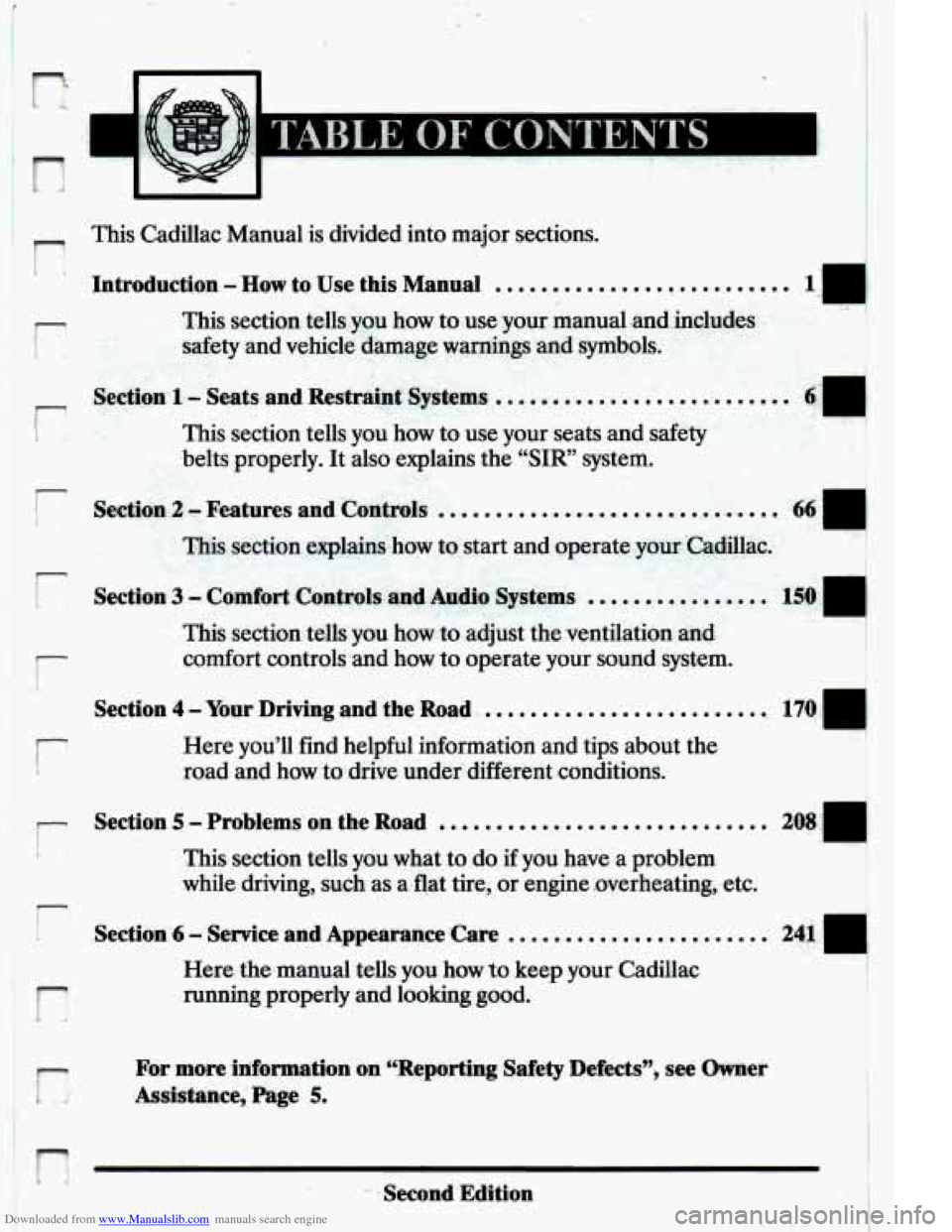
Downloaded from www.Manualslib.com manuals search engine n This Cadillac Manual is divided into major sections.
I1
.Introduction-How to Use this Manual ..........................
- 2 This section tells. you ‘how to use your manual and includes
. . safety and vehicle damage warnings .and symbols.
,.
Section-1.- Seats and Restrainat: Systems .......................... 6.; 1 7 ‘, -. I
‘i This section tells you how to use your seats and safety
belts properly. It also.explains the
“SIR” system.
p Section 2 - Features and Contmls ......................... ,. ....
Ws.section explains how to start and operate your Caditlac.
.This section .tells you how- to .adjust the ventilation and
comfort controlsand how to operate your sound system.
Section4-YourDrivingandtheRoad. .......................... 170 1
iI
Here you’ll find helpful information and tips about the
road and how. to drive under’ different conditions.
. Section5-’ProblemsontheRoad .............................
Thissection tells you.what to do if you have a problem
while driving, such as a..flat tire, or
engine.overheating,.etc.
I
r .Section 6 - Service and AppearanceCare .......................
Herethe.manua1 tells you how.to keep your Cadillac
running properly and looking
good.
For more information on ‘‘Reporting Safety Defects”, see her
I7 .hsistance,hge 5.
...
Page 50 of 398
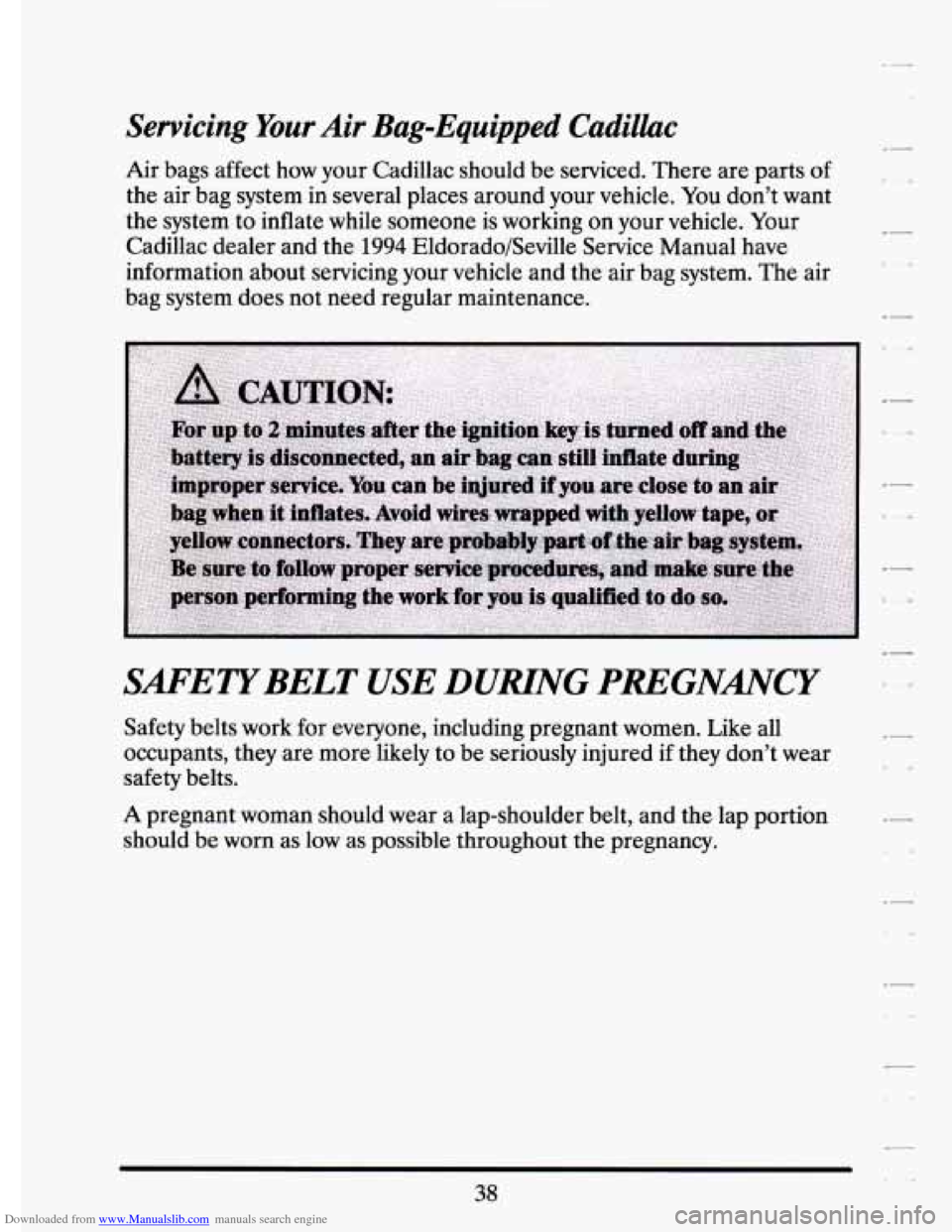
Downloaded from www.Manualslib.com manuals search engine Servicing Your Air Bag-Equipped Cadilhc
Air bags affect how your Cadillac should be serviced. There are parts of
the air bag system in several places around your vehicle. You don’t want
the system to inflate while someone is working on your vehicle. Your
Cadillac dealer and the
1994 Eldorado/Seville Service Manual have
information about servicing your vehicle and the air bag system. The air
bag system does not need regular maintenance.
SAFETYBELT USE DURING PREGNANCY
Safety belts work for everyone, including pregnant women. Like \
all
occupants, they are.more likely to be seriously injured
if they don’t wear
safety belts.
A pregnant woman should wear a lap-shoulder belt, and the lap portion
should be worn as low as possible throughout the pregnancy.
38
r
c-
Page 83 of 398
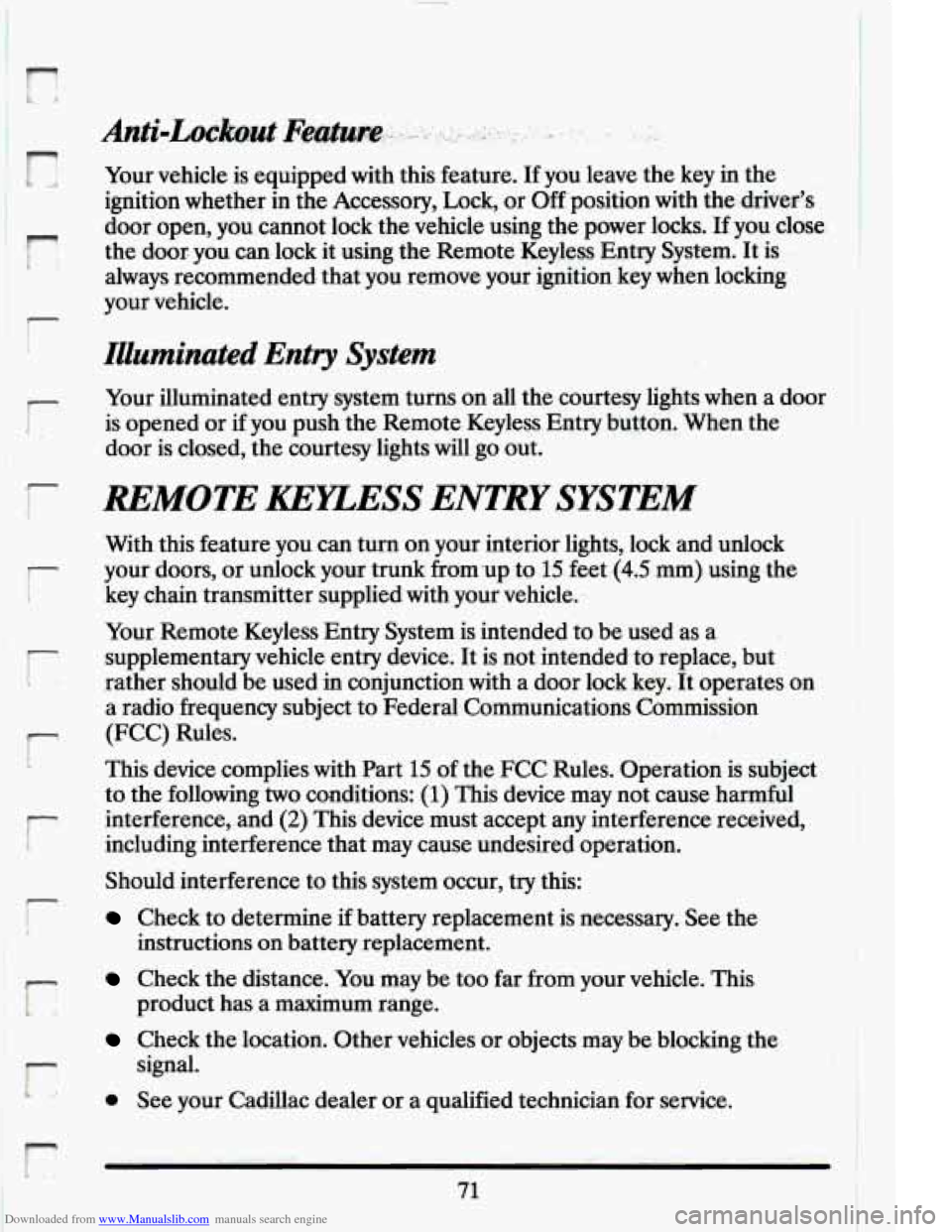
Downloaded from www.Manualslib.com manuals search engine r
r
r t
r
ir
r:
r
Your vehicle is equipped with this feature. If you leave the key in the
ignition whether in the Accessory, Lock,
or Off position with the ,driver's
door open, you cannot lock,the vehicle using the power locks.
If you close
the door you can.lo.ck it using the Remote Keyless Entry System. It is
always recommended. that- you rem0v.e your ignition
key when locking
your vehicle.
Illuminated Entry System
Your illuminated.entry system turns on all the courtesy lights when a door
is opened or if you push the Remote Keyless. Entry button. .When. the
door is closed, the courtesylights will go out.
RElMOTE KEIZESS ENTRY SYSTEM
With this feature you can turn on your interior lights, lock.and unlock
your doors, or unlock your trunk from-up
to 15 feet (4.5 mm) using the
key chain transmitter supplied with your vehicle
...
Your. Remote Keyless Entry System is intended to be used as a
supplementary vehicle entry device. It is not intended to replace, but
rather should be used in conjunction with a door lock key. It operates on
a radio frequency subject to Federal Communications Commission
(FCC) Rules.
This device complies with Part 15 of the FCC Rules. Operation.
is subject
to the following
two conditions: (1) This device may not cause harmful . ,I
interference,.and (2) This device must accept any interference received,
including interference that may cause undesired operation.
Should interference- to this system occur, try this:
Check to determine if battery replacement is necessary. See the
Check the distance. You may be too far from your vehicIe. This
Check the location. Other vehicles or objects may be. blocking the-
0, See your Cadillac dealer ora qualified technician for service.
instructions
on battery replacement..
product has a maximum range.
signal.
71
Page 84 of 398
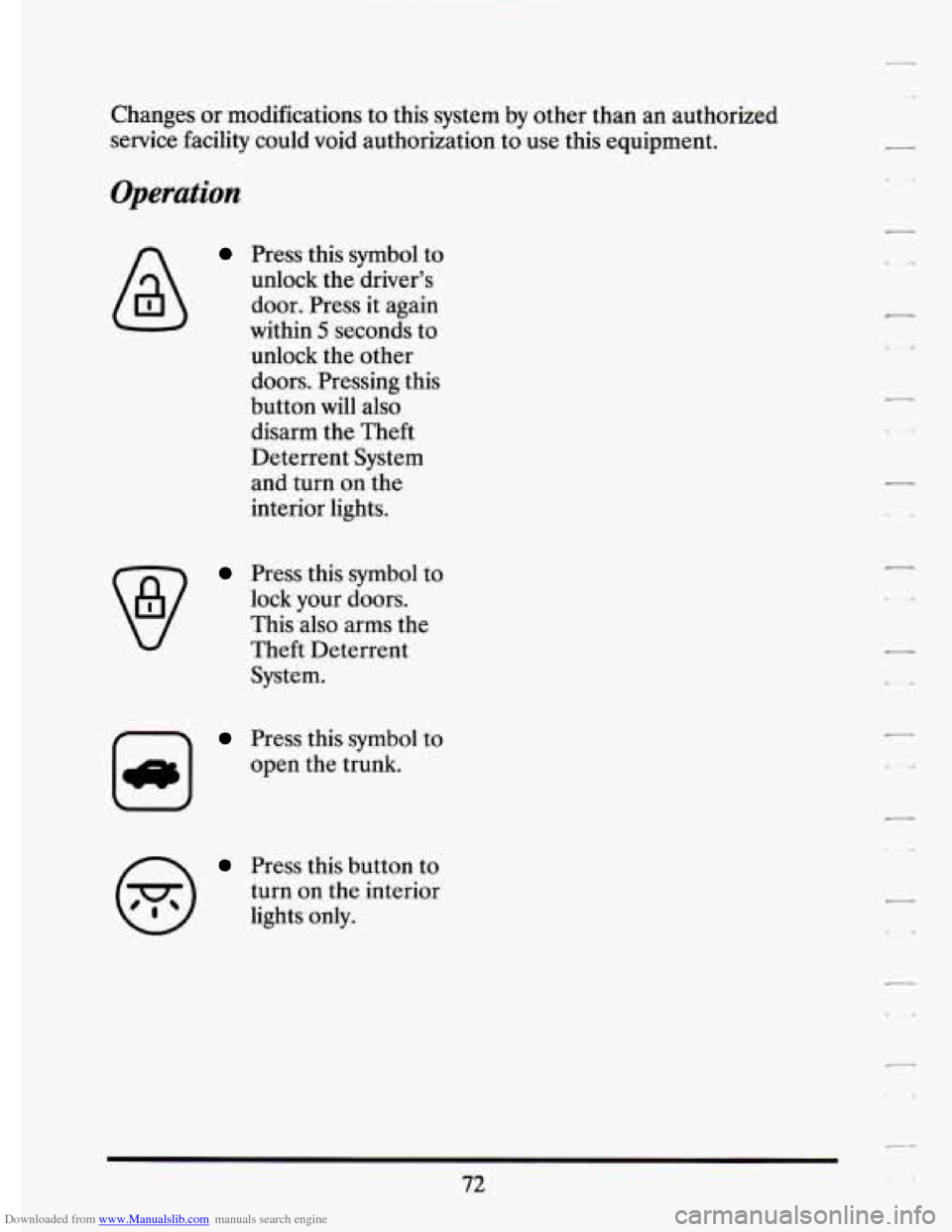
Downloaded from www.Manualslib.com manuals search engine Changes or modifications to this system by other than an authorized
service facility could void authorization to use this equipment.
Operation
Press this symbol to
unlock the driver’s
door. Press it again
within
5 seconds to
unlock the other
doors. Pressing this
button will also
disarm the Theft
Deterrent System
and turn on the
interior lights.
Press this symbol to
lock your doors.
This also arms the
Theft Deterrent
System.
m
Press this symbol to
open the trunk.
Press this button to
turn on the interior
lights only.
72
Page 94 of 398
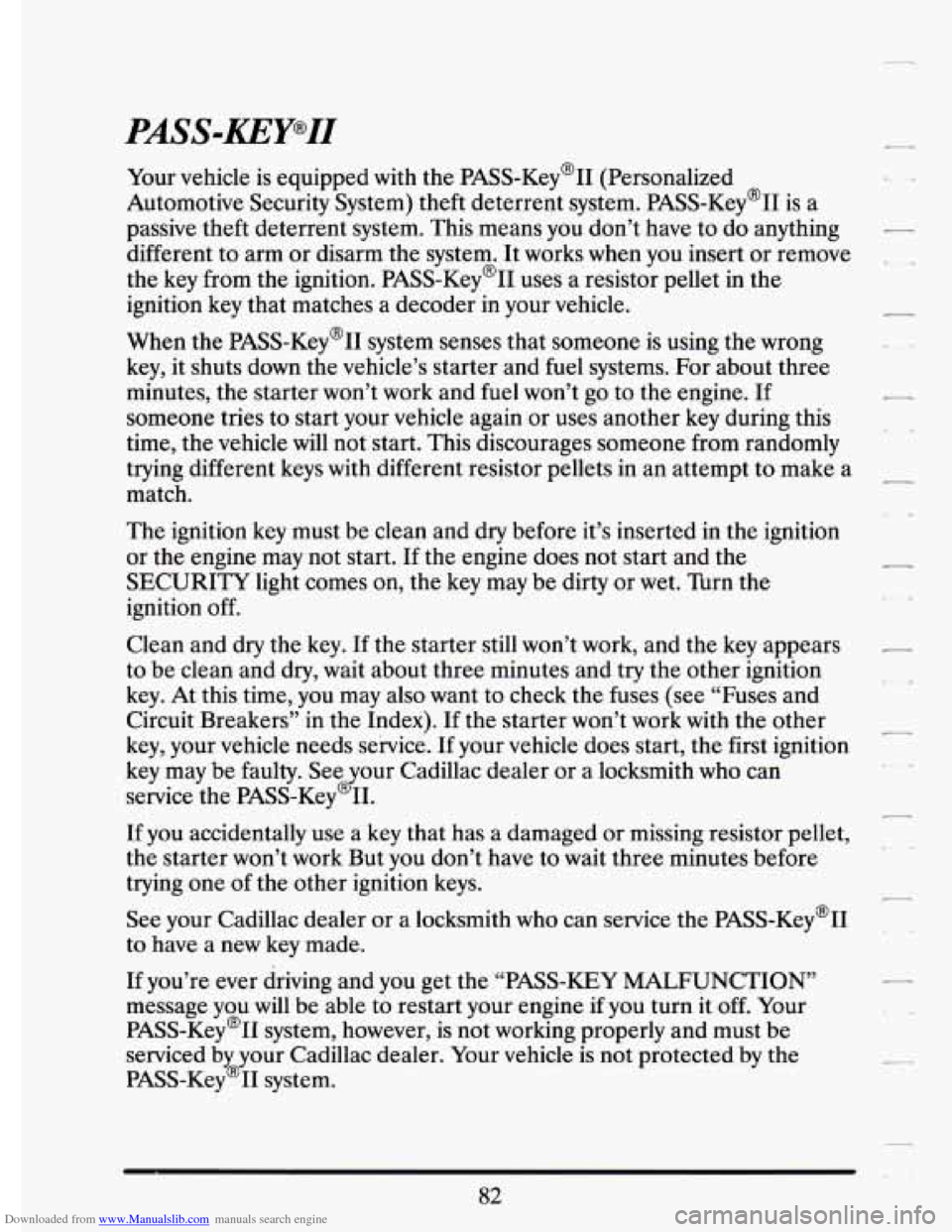
Downloaded from www.Manualslib.com manuals search engine PASS-KEY@II
Your vehicle is equipped with the PASS-Key@II (Personalized
Automotive Security System) theft deterrent system. PASS-Key@II
is a
passive theft deterrent system.
This means you don’t have to do anything
different to arm or disarm the system. It works when you insert or remove
the
key from the ignition. PASS-Key@II uses a resistor pellet in the
ignition key that matches a decoder in your vehicle.
When the PASS-Key@II system senses that someone is using the wrong
key, it shuts down the vehicle’s starter and
fuel systems. For about three
minutes, the starter won’t work and fuel won’t go to the engine.
If
someone tries to start your vehicle again or uses another key during this
time, the vehicle will not start. This discourages someone from randomly
trying different keys with different resistor pellets
in an attempt to make a
match.
The ignition key must be clean and dry before it’s inserted in the ignition
or the engine may not start. If
the engine does not start and the
SECURITY light comes on, the key may be dirty or wet. Turn the
ignition off.
-
c .*
Clean and dry the key. If the starter still won’t work, and the key appears -
to be clean and dry, wait about three minutes and try the other ignition
key. At this time, you may also want to check the fuses (see “Fuses and
Circuit Breakers”
in the Index). If the starter won’t work with the other
key, your
vehicle needs seivice. If your vehicle does start, the first ignition
key may be faulty. See your Cadillac dealer or a locksmith who can
service the PASS-Key@II.
If you accidentally use a
key that has a damagea or missing resistor pellet,
the starter won’t work But you don’t have to wait three minutes before
trying one of the other ignition keys.
CI
-
-
See your Cadillac dealer or a locksmith who can service the PASS-Key@II
to have a new key made.
If you’re ever driving and you get the “PASS-KEY MALFUNCTION”
message you
will be able to restart your engine if you turn it off. Your
PASS-Key% system, however, is not working properly and must be
serviced by your Cadillac dealer. Your vehicle is not protected by the
PASS-Key@II system.
82
Page 96 of 398
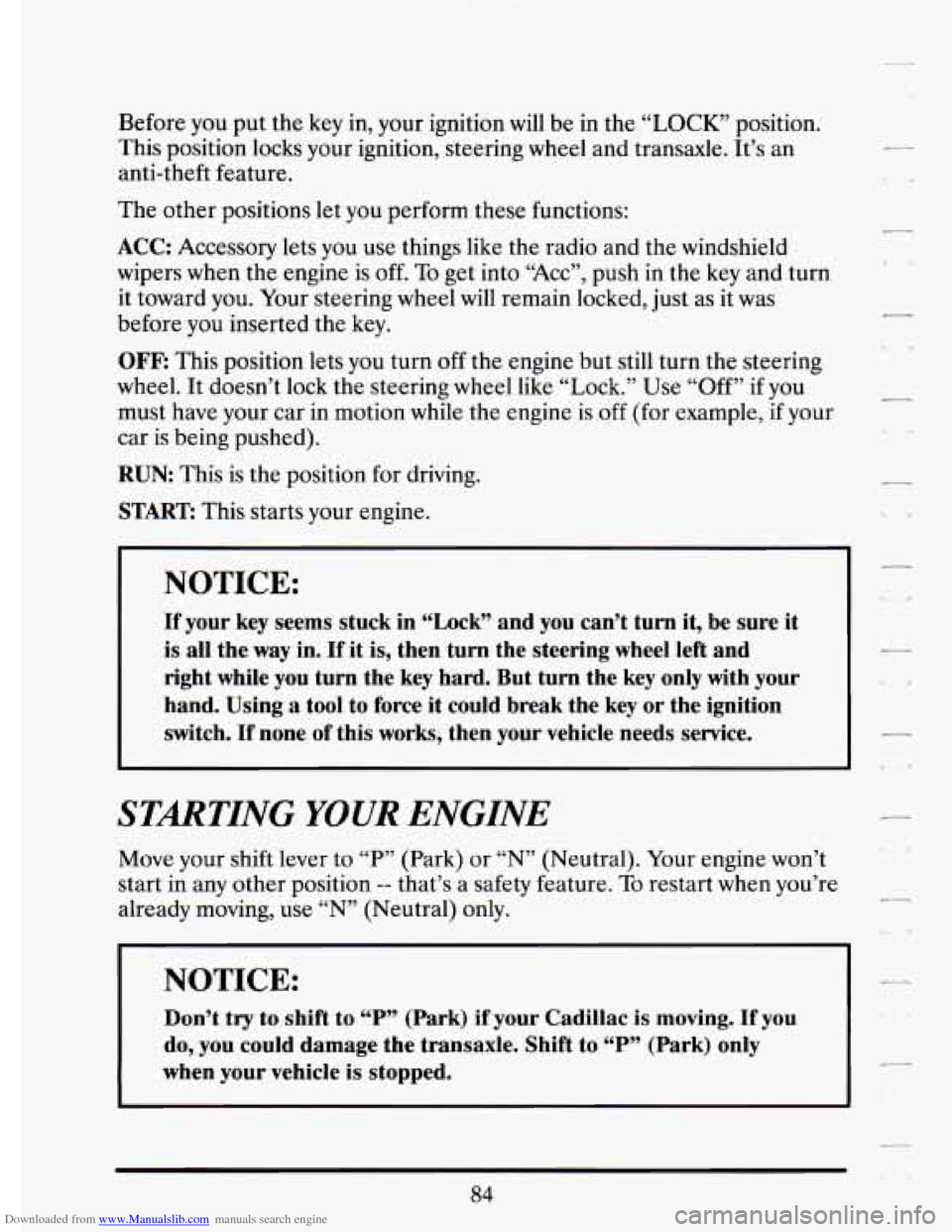
Downloaded from www.Manualslib.com manuals search engine Before you put the key In, your ignition will be in the “LOCK” position.
This position locks your ignition, steering
wheel and transaxle. It’s an
anti-theft feature.
The other positions let
you perform these functions:
ACC: Accessory lets you use things like the radio and the windshield
wipers when the engine is off. To get into “ACC”, push
in the key and turn
it toward you. Your steering wheel
will remain locked, just as it was-
before you inserted the key.
OFF: This position lets you turn off the engine but still turn the steering
wheel. It doesn’t lock the steering wheel like “Lock.” Use “Off”
if you
must have your car in motion while the engine is off (for example, if your
car is being pushed).
RUN This is the position for driving.
STARR This starts your engine.
NOTICE:
If your key seems stuck in “Lock” and you can’t turn it, be sure it
is
all the way in. If it is, then turn the steering wheel left and
right while you turn the key hard. But turn the key only with your
hand. Using
a tool to force it could break the key or the ignition
switch. If none of this works, then your vehicle needs service.
STARTING YOUR ENGINE
Move your shift lever to “P” (Park) or “N” (Neutral). Your engine won’t
start in any other position
-- that’s a safety feature. To restart when you’re
already moving, use
“N” (Neutral) only.
.-
,.
NOTICE: -
Don’t try to shift to “P” (Park) if your Cadillac is moving. If you
I
do, you could damage the transaxle. Shift to “P” (Park) only
when your vehicle
is stopped.
84
Page 103 of 398

Downloaded from www.Manualslib.com manuals search engine tf
r
I.
NOTICE:
If your vehicle seems to start up rather slowly, or if it seems not
to shift gears
as you go faster, something may be wrong with a
transaxle system sensor. If you drive very far that way, your
vehicle can be damaged.
So, if this happens, have pour vehicle
serviced right
away Until then, you can use “2” (Second Gear)
when you are driving less than
35 mph (56 h/h) and @)
(Overdrive) for higher speeds.
F 1, 3 (Third Gear)
This is like
@, but you never go into Overdrive.
Here are some times you might choose
“3” instead of @:
- When driving on hilly, winding roads
- When towing a trailer, so there is less shifting.between gears
- When going down a steep hill
2 (Second Gear)
This position gives you more power but lower fuel economy. You can
use
“2” on hills. It can help control your speed as you go down steep
mountain roads, but then you would also want
to use your brakes off
and on.
r NOTICE:
Don’t drive in (‘2” (Second Gear) for more than 5 miles (8 km),
or at speeds overS5 mph (88 km/h), or you can damage your
transaxle.
Use “@)” or c63” as much as possible.
Don’t shift into
“2” u.nless you are going slower than 65 mph
(105 Wh), or you can damage your engine.
91
Page 144 of 398
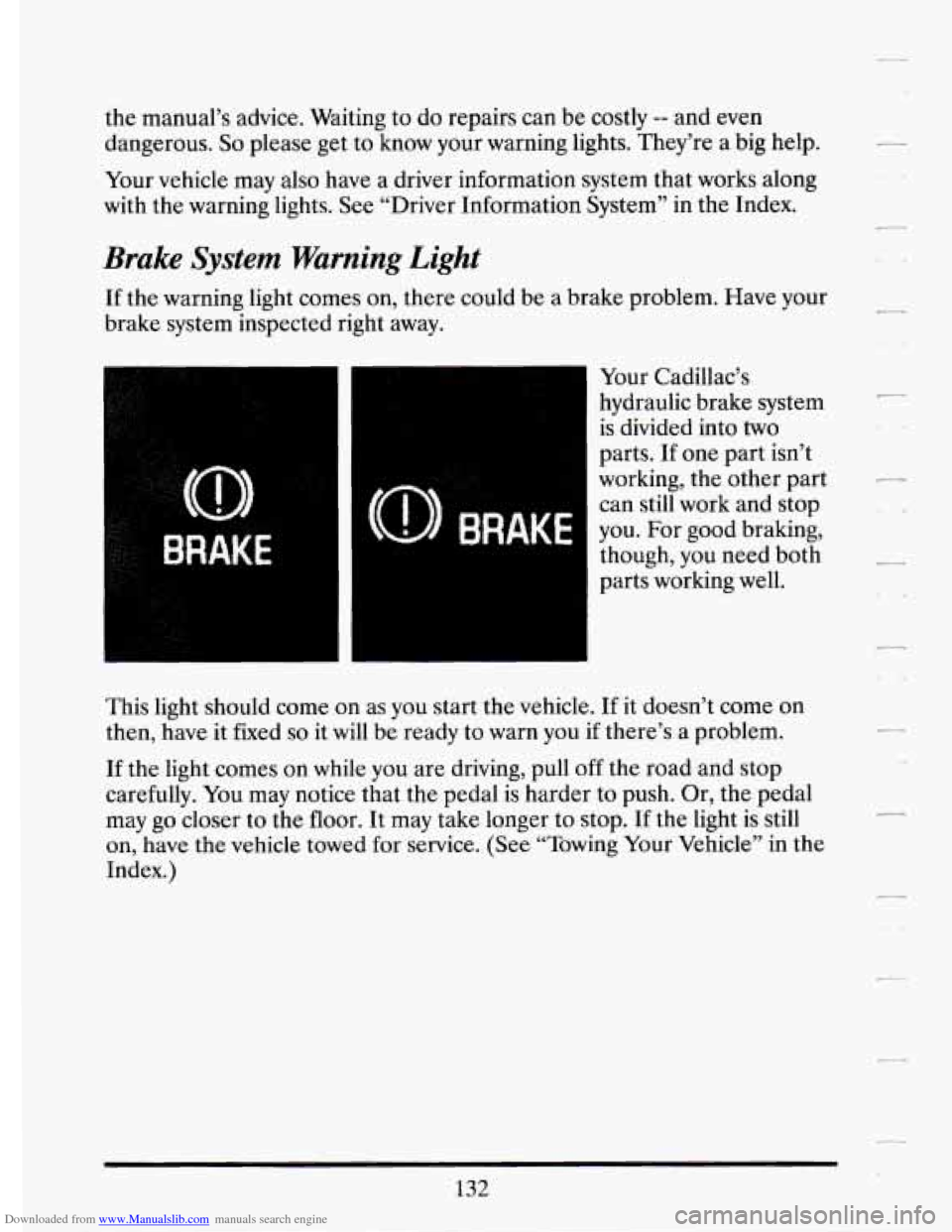
Downloaded from www.Manualslib.com manuals search engine the manual’s advice. Waiting to do repairs can be costly -- and even
dangerous.
So please get to know your warning lights. They’re a big help.
Your vehicle may also have a driver information system that works along
with the warning lights. See “Driver Information System”
in the Index.
Brake System Warning Light
If the warning light comes on, there could be a brake problem. Have your
brake system inspected right away.
Your Cadillac’s
hydraulic brake system
is divided into two
parts. If one part isn’t
working, the other part
can still work and stop
you. For good braking,
though, you need both
parts working well.
This light should come
on as you start the vehicle. If it doesn’t come on
then, have it fixed
so it will be ready to warn you if there’s a problem.
If the light comes on while you are driving, pull off the road and stop
carefully.
You may notice that the pedal is harder to push. Or, the pedal
may go closer to the floor. It may take longer to stop. If the light
is still
on, have the vehicle towed for service. (See “Towing Your Vehicle” in the
Index.)
132